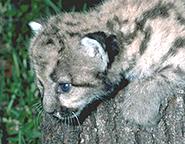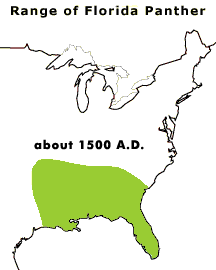
Florida
Panther
The Florida Panther,
Felis concolor coryi, was adopted as Florida's state mammal in 1982. It is one of many
subspecies of the American lion,
Felis concolor. This large cat is tan in color and ranges from six to eight feet long. Its tail makes up two-thirds of the animal's total length. Other common names for various subspecies of the American lion include cougar, mountain lion, catamount, and puma.
Photo: Florida Panther adult.
Photo ©
Larry Richardson, U.S. Fish and Wildlife Service.
The Florida Panther lives in upper dry land habitats such as hardwood hammocks, pine
flatwoods, and thicket swamps near wetlands. Although it does not like extremely wet places, it will wade across waterways if necessary to find food and drier land. The Florida Panther generally rests in and around trees during the day. At daybreak and nightfall, it hunts deer, wild hogs, raccoons, and rabbits that live in the wetlands. Border habitats between woodlands and wetlands provide the ideal home for the Florida Panther.
 The Florida Panther tends to be a solitary animal. It lives, hunts, and mates in a very specific home range or territory within these border habitats. The male Florida Panther requires a home range of approximately 250 square miles through which no other male can cross without a fight. The female Florida Panther requires a home range of only 70-200 square miles. The size difference between male and female home ranges allows the male to breed with more than one female, increasing the chances of passing on his genes to another generation.
Photo: Florida Panther cub. Photo
©
Larry Richardson, U.S. Fish and Wildlife Service.
The Florida Panther tends to be a solitary animal. It lives, hunts, and mates in a very specific home range or territory within these border habitats. The male Florida Panther requires a home range of approximately 250 square miles through which no other male can cross without a fight. The female Florida Panther requires a home range of only 70-200 square miles. The size difference between male and female home ranges allows the male to breed with more than one female, increasing the chances of passing on his genes to another generation.
Photo: Florida Panther cub. Photo
©
Larry Richardson, U.S. Fish and Wildlife Service.
An adult Florida Panther has two to three years to establish a home range before it begins to breed. Female Florida Panthers breed once every two years between October and March. The male does not stay with the female to help raise the cubs. After a gestation period of 92-96 days, the female Florida Panther produces a litter of 1-3 cubs. For the first two months of their lives, the cubs remain in their mother's care in the dry, safe den she prepared. While their mother is away hunting, the cubs are helpless. It is important that their den be located in an area that provides safe cover, as well as plenty of nearby
prey. Florida Panther cubs will remain with their mother until they are approximately 18 months old and capable of hunting on their own. At that time they must strike out and establish their own home ranges.
Prior to the 1600s, the Florida Panther hunted deer and other land mammals on high ground surrounding wetlands throughout southeastern North America.
 In the 1600s, settlers began moving into the panther's territory. The settlers crowded the panther into smaller areas and used the animal's food resources. As a consequence, the panther was forced to look for new food sources that often included the settlers' livestock. The panther became greatly feared and hated. In 1887, the state of Florida authorized a $5 bounty for panther scalps. As one might expect, this incentive caused a dramatic decline in the Florida Panther population.
Image: Change in the range of the Florida Panther from 1500 A.D. to the present. Graphic courtesy
of Florida Panther Net, Florida Fish and Wildlife Conservation
Commission.
In the 1600s, settlers began moving into the panther's territory. The settlers crowded the panther into smaller areas and used the animal's food resources. As a consequence, the panther was forced to look for new food sources that often included the settlers' livestock. The panther became greatly feared and hated. In 1887, the state of Florida authorized a $5 bounty for panther scalps. As one might expect, this incentive caused a dramatic decline in the Florida Panther population.
Image: Change in the range of the Florida Panther from 1500 A.D. to the present. Graphic courtesy
of Florida Panther Net, Florida Fish and Wildlife Conservation
Commission.
In 1967, the U.S. Department of Interior declared the Florida Panther to be an
endangered species. Since then, this cougar subspecies has become
genetically isolated and is in danger of becoming
extinct. Several measures have been taken to protect the animal from disappearing completely. One such measure involves breeding programs. Wildlife biologists have bred Florida Panthers in captivity to increase their population. They have also introduced the Texas Mountain Lion--another subspecies of Felis concolor and a cousin to the panther--into the wild population of the Florida Panther. The biologists hope that these two subspecies will breed, reducing the occurrence of congenital heart defects and abnormally low sperm counts, which are common symptoms of small population
inbreeding.
Another effort to protect the Florida Panther involves acquiring and preserving habitat in which the animal and its prey can live. In 1989, the Florida Panther National Wildlife Refuge was established to place 24,000 acres of panther habitat under protection. Other federal and privately owned lands have also been set aside as preserves for the Florida Panther. In total, there are approximately 2.2 million acres or 3,438 square miles of habitat over which the 30 to 50 wild Florida Panthers roam. This habitat lies northwest of Everglades National Park; State Road 29 runs through it from north to south and Interstate 75 runs through it from east to west.
Although the breeding programs and habitat preserves represent a great deal of effort toward protecting the Florida Panther from extinction, they may not be enough to save the animal. Data indicates that a minimum of 50 adult panthers is needed in order to have a self-sustaining population. A self-sustaining population is one that does not need to be artificially supplemented with breeding programs. The current land reserves are only large enough to accommodate 13 males at their full home range requirements of 250 square miles. The 30 to 50 existing wild Florida Panthers do not have sufficient protected territory in which to establish individual home ranges of adequate size. Such small home ranges result in the increased occurrence of inbreeding as well as increased competition for mates and food.
The loss of bordering habitats also affects what little prey exists for the panther. For example, flooding of the Everglades may destroy its grassy edges, the primary food source of deer and other panther prey.
It is important to understand the relationship between
predator and prey population sizes. The number of prey controls the maximum size of a predator population. As long as panther prey is being over-hunted by the crowded panthers and destroyed by humans, the panther population will not be able to grow.
For more information on the
Florida Panther, visit:
Florida Panther Society
Friends of the Florida Panther Refuge
Florida Panther Net
U.S. Fish and Wildlife Service Florida Panther Species Account
Panther Home PageGlossary ..|.. Related Links ..|.. References |..PBL Model
Home ..|.. Teacher Pages ..|.. Modules & Activities
HTML code by Chris
Kreger
Maintained by ETE Team
Last updated
April 28, 2005
Some images © 2004 www.clipart.com
Privacy Statement and Copyright © 1997-2004 by Wheeling Jesuit University/NASA-supported Classroom of the Future. All rights reserved.
Center for Educational Technologies, Circuit Board/Apple graphic logo, and COTF Classroom of the Future logo are registered trademarks of Wheeling Jesuit University.
